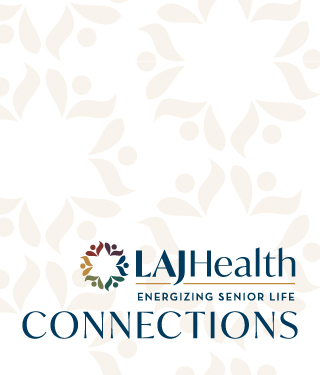Los Angeles Jewish Home Accepts New Resident Applications


Los Angeles Jewish Home Accepts New Resident Applications
Welcoming and caring for new residents to the Los Angeles Jewish Home is the essence of our mission. Now, after a year-long pause in admissions caused by the global pandemic, the Jewish Home is excited to be accepting new residents once again, in addition to participants in our community-based programs.
The news, says Dale Surowitz, CEO and president of the Jewish Home, is a breath of fresh air. "During COVID, we took every measure possible to ensure the continued health and safety of the seniors in our care, and that meant refraining from bringing people in—even visitors," he says. "But expanding our capacity to accommodate new residents is a vital part of our mission. Now that vaccines are here, and 99 percent of our residents have received both doses (as well as the large majority of our staff), we're reopening the admissions process so we can serve even more members of the community."
That focus on service, Dale points out, is a key part of what distinguishes the Jewish Home from others—and what has long made it such a desirable place to live and receive care. "One of the things that makes the Jewish Home unique is the breadth of services we offer. From short-term rehab to hospice, independent living to home health, to memory care, we have the expertise to support our residents at their varying levels of need," he says.
Skilled nursing is another stand-out strength of the Jewish Home, and there are immediate openings for seniors requiring hands-on skilled nursing assistance. "The Jewish Home typically has wait lists for available spaces in our skilled nursing facilities; it's uncommon to have availability as we currently do," Dale says. "This represents a rare opportunity for people to get into the Home now, before we reach capacity, which will happen quickly."
What the residents will find at the Jewish Home, he notes, are skilled, compassionate, and dedicated staff who treat them like family—and a warm, nurturing environment that helps them make the most out of every day. Dale, who began in his current position last October, after a decade-plus involvement as a leadership volunteer on multiple Jewish Home boards, says there is no place quite like the Home.
"As an acute care hospital CEO for over 30 years, I've had a chance to see people as they come into the hospital from various facilities," says Dale, who previously served as CEO of Providence Cedars-Sinai Medical Center. "You can tell what kind of care they received before being admitted to the hospital, and it's obvious the Jewish Home is incredibly special, with talented and compassionate staff who are truly invested in the residents."
There is another key component that sets the Jewish Home apart, Dale says: its emphasis on coordinated care. "Whether seniors want to age in place at home or in a skilled nursing facility, there is a real lack of coordinated services and information flow between various care providers," he observes. "The Jewish Home is stepping into that gap, making it seamless for seniors and giving them critical peace of mind."
One example of the Jewish Home's innovation on that front is its recent launch of the Brandman Health Plan. Designed for the patient with chronic special needs, the plan offers benefits to anyone in Los Angeles County who is Medicare-eligible and has diabetes, chronic heart failure, cardiovascular disorders, or dementia. "Too often, these folks bounce between doctors' offices, and there's no communication going back and forth, so care providers can end up working at cross purposes," Dale says. "The Brandman Health Plan eliminates this problem, making sure our seniors get the right care, in the right place, at the right time."
Residents of the Jewish Home, along with members of the larger community, also have access to services like the Brandman Centers for Senior Care, a Program of All-inclusive Care for the Elderly (PACE). Through this program, residents and others receive medical services, physical therapy, social services, and nutritional counseling, as well as exceptional adult day healthcare that engages them intellectually, physically, and socially.
Dale says all of this adds up to make the Jewish Home unlike anyplace else—a prime destination for seniors across Los Angeles. "We're here for them, whoever they are and whatever their needs," he affirms. He looks forward to welcoming even more seniors into the Jewish Home family fold, and he encourages them to reach out and learn more. "We're eager to hear from new applicants," he says, "and can't wait to find out how we can help." For more information, go to lajhealth.org, or call 855-227-3745.